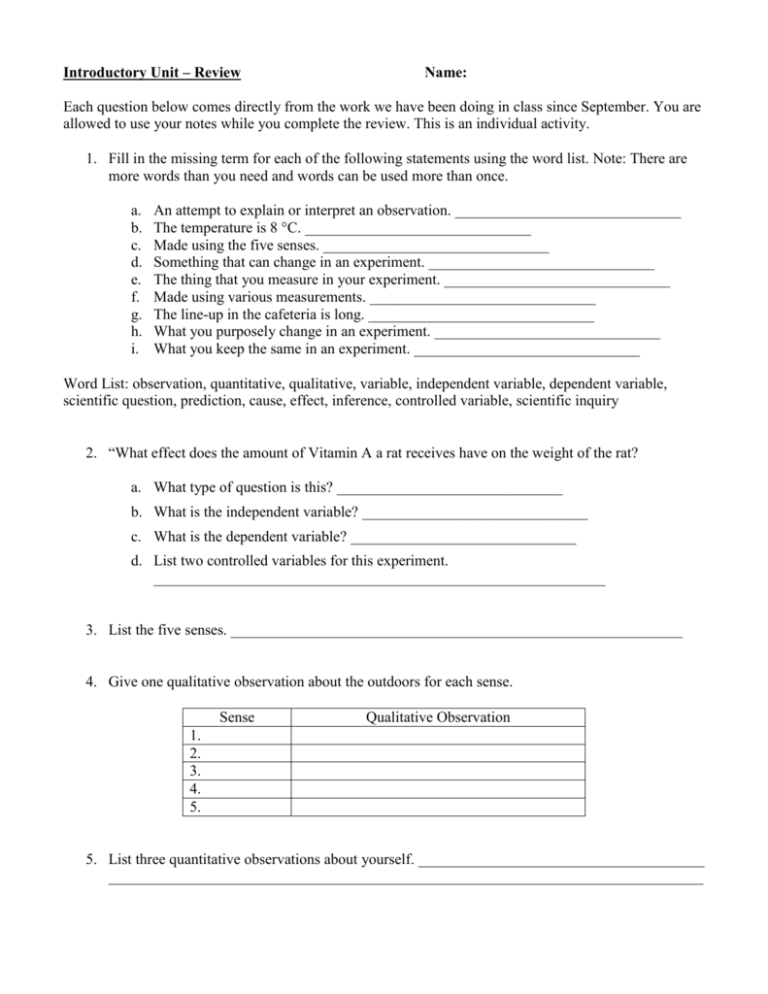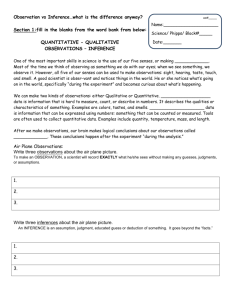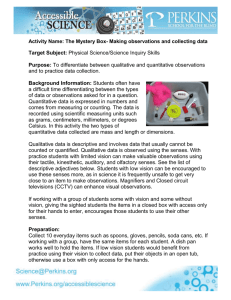Introductory Unit – Review
advertisement

Introductory Unit – Review Name: Each question below comes directly from the work we have been doing in class since September. You are allowed to use your notes while you complete the review. This is an individual activity. 1. Fill in the missing term for each of the following statements using the word list. Note: There are more words than you need and words can be used more than once. a. b. c. d. e. f. g. h. i. An attempt to explain or interpret an observation. ______________________________ The temperature is 8 °C. ______________________________ Made using the five senses. ______________________________ Something that can change in an experiment. ______________________________ The thing that you measure in your experiment. ______________________________ Made using various measurements. ______________________________ The line-up in the cafeteria is long. ______________________________ What you purposely change in an experiment. ______________________________ What you keep the same in an experiment. ______________________________ Word List: observation, quantitative, qualitative, variable, independent variable, dependent variable, scientific question, prediction, cause, effect, inference, controlled variable, scientific inquiry 2. “What effect does the amount of Vitamin A a rat receives have on the weight of the rat? a. What type of question is this? ______________________________ b. What is the independent variable? ______________________________ c. What is the dependent variable? ______________________________ d. List two controlled variables for this experiment. ____________________________________________________________ 3. List the five senses. ____________________________________________________________ 4. Give one qualitative observation about the outdoors for each sense. Sense Qualitative Observation 1. 2. 3. 4. 5. 5. List three quantitative observations about yourself. ______________________________________ _______________________________________________________________________________ 6. What are three instruments you could use to make quantitative observations? _______________________________________________________________________________ 7. You enter your house to find the back door open and a half eaten peanut butter sandwich on the kitchen counter. Nobody is home. What inference can you make? What do you think happened based on your observations? _______________________________________________________________________________ _______________________________________________________________________________ 8. What do you have to “control” variables in an experiment? _______________________________________________________________________________ _______________________________________________________________________________ 9. Underline the variables in the following statements. Put an “I” next to the independent variable and a “D” next to the dependent variable. a. The time it takes to run a kilometre depends on the amount of exercise a person gets. b. The higher the temperature of water, the faster an egg will cook. c. An investigation was done to see if keeping the lights on for different amounts of time each day affected the number of eggs chickens laid. 10. Re-write the following statement so that it is a scientific question (one that can be tested). “The number of berries on a blueberry bush depends on how much water it receives.” _______________________________________________________________________________ _______________________________________________________________________________ 11. Give ONE inference for each of the following observations. a. My car won’t start. b. The classroom is quiet. c. She missed the bus. Introductory Unit – Review Answers Each question below comes directly from the work we have been doing in class since September. You are allowed to use your notes while you complete the review. This is an individual activity. 1. Fill in the missing term for each of the following statements using the word list. Note: There are more words than you need and words can be used more than once. a. b. c. d. e. f. g. h. i. An attempt to explain or interpret an observation. Inference The temperature is 8 °C. Quantitative observation Made using the five senses. Qualitative observation Something that can change in an experiment. Variable The thing that you measure in your experiment. Dependent variable / effect Made using various measurements. Quantitative observation The line-up in the cafeteria is long. Qualitative observation What you purposely change in an experiment. Independent variable / cause What you keep the same in an experiment. Controlled variable Word List: observation, quantitative, qualitative, variable, independent variable, dependent variable, scientific question, prediction, cause, effect, inference, controlled variable, scientific inquiry 2. “What effect does the amount of Vitamin A a rat receives have on the weight of the rat? a. What type of question is this? Scientific question b. What is the independent variable? Amount of Vitamin A c. What is the dependent variable? Weight of the rat d. List two controlled variables for this experiment. Food, water, location, type of rat, exercise amount, age of rat 3. List the five senses. See, hear, smell, taste, touch 4. Give one qualitative observation about the outdoors for each sense. Sense 1. See 2. Hear 3. Smell 4. Taste 5. Touch Qualitative Observation Trees, bushes, grass, other plants, buildings, vehicles, sky, clouds, animals, insects etc… Animals, vehicles, sirens, bells, insects etc… Plants, exhaust, food etc… Plants, wind, water, food etc… Plants, animals, buildings, ground etc… 5. List three quantitative observations about yourself. Height, weight, hair length etc… 6. What are three instruments you could use to make quantitative observations? Ruler, scale, measuring cups, timer, clock, measuring spoons etc… 7. You enter your house to find the back door open and a half eaten peanut butter sandwich on the kitchen counter. Nobody is home. What inference can you make? What do you think happened based on your observations? Someone forgot to close the door when s/he left; the sandwich was not important. Something happened in the back yard and s/he left the door open when s/he left to deal with it, only eating half of the sandwich. There was a kidnapping, and the sandwich was left behind. Someone had an allergic reaction to the sandwich and had to be taken to the hospital – the door was left open in the process. 8. What do you have to “control” variables in an experiment? You control variable so that you know which independent variable caused the dependent variable to change. 9. Underline the variables in the following statements. Put an “I” next to the independent variable and a “D” next to the dependent variable. a. The time it takes to run a kilometre (D) depends on the amount of exercise (I) a person gets. b. The higher the temperature (I) of water, the faster an egg will cook (D). c. An investigation was done to see if keeping the lights on for different amounts of time (I) each day affected the number of eggs chickens laid (D). 10. Re-write the following statement so that it is a scientific question (one that can be tested). “The number of berries on a blueberry bush depends on how much water it receives.” What effect does the amount of water have on how many blueberries will be produced? 11. Give ONE inference for each of the following observations. a. My car won’t start. There is no gas. It is broken. b. The classroom is quiet. It is empty. There is a test. Everyone is working quietly. c. She missed the bus. She woke up late. The bus cam early






